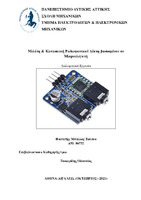| dc.contributor.advisor | Τσακιρίδης, Οδυσσέας | |
| dc.contributor.author | Μπάλλας, Τισιάνο | |
| dc.date.accessioned | 2022-06-15T09:04:19Z | |
| dc.date.available | 2022-06-15T09:04:19Z | |
| dc.date.issued | 2021-10 | |
| dc.identifier.uri | https://polynoe.lib.uniwa.gr/xmlui/handle/11400/2327 | |
| dc.identifier.uri | http://dx.doi.org/10.26265/polynoe-2178 | |
| dc.description.abstract | Ο στόχος της παρούσας διπλωματικής εργασίας είναι η μελέτη και η κατασκευή ενός ραδιοφωνικού δέκτη FM μέσω της χρήσης ενός μικροελεγκτή arduino . Για να πραγματοποιηθεί το πειραματικό μέρος έπρεπε να χρησιμοποιήσουμε τόσο υλισμικό για την κατασκευή του κυκλώματος του δεκτή καθώς και λογισμικό για τον έλεγχο του δεκτή. Στην παρούσα Διπλωματική εργασία η θεωρητική τεκμηρίωση αφορά τον ρόλο της διαμόρφωσης καθώς και τα είδη διαμορφώσεων, με μεγαλύτερη εστίαση στην διαμόρφωση συχνότητας, την οποία χρησιμοποιούμε στην FM ραδιοφωνία Επιπλέον εστιάζουμε και στην διαδικασία της αποδιαμόρφωσης FM που χρησιμοποιεί ο δέκτης στην λήψη του σήματος και το πώς αυτή μας εξυπηρετεί, ώστε να έχουμε την βέλτιστη ακουστική αναπαραγωγή στην έξοδο του συστήματος μας . Στην παρούσα διπλωματική εργασία εισαγάγετε η
έννοια του μικροελεγκτή, ο τρόπος λειτουργίας του, δίνοντας μεγάλη βαρύτητα στους μικροελεγκτές της οικογένειας AVR. Αναλύεται η αρχιτεκτονική του ATMEGA328P που χρησιμοποιούμε στην δικιά μας περίπτωση. Κάνοντας χρήσης της πλατφόρμας ARDUINO αναλύουμε τα κύρια χαρακτηριστικά της και επικεντρωνόμαστε στην έκδοση ARDUINO NANO οπού είναι και ο τύπος που θα χρησιμοποιηθεί στον FM δεκτή. Στην συγκεκριμένη κατασκευή που είναι συνδυασμός υλισμικού και λογισμικού θα πρέπει πρώτα να συνδεθούν όλες οι μονάδες μεταξύ τους δηλαδή το Arduino nano ο δέκτης TEA5767HN και η οθόνη πληροφοριών και μετά η κατασκευή του κώδικα που είναι και η πιο απαιτητική εργασία. | el |
| dc.format.extent | 118 | el |
| dc.language.iso | el | el |
| dc.publisher | Πανεπιστήμιο Δυτικής Αττικής | el |
| dc.rights | Αναφορά Δημιουργού - Μη Εμπορική Χρήση - Παρόμοια Διανομή 4.0 Διεθνές | * |
| dc.subject | Σήμα | el |
| dc.subject | Διαμόρφωση | el |
| dc.subject | Αποδιαμόρφωση | el |
| dc.subject | FM | el |
| dc.subject | Λήψη | el |
| dc.subject | Ι2C | el |
| dc.subject | Μικροελεγκτές | el |
| dc.subject | Arduino | el |
| dc.subject | Tea5767hn | el |
| dc.subject | Κώδικας | el |
| dc.subject | Ολοκληρωμένα κυκλώματα | el |
| dc.subject | PLL | el |
| dc.subject | AVR | el |
| dc.title | Μελέτη & κατασκευή ραδιοφωνικού δέκτη βασισμένου σε μικροελεγκτή | el |
| dc.title.alternative | Design & construction of a radio receiver based on a microcontroller | el |
| dc.type | Διπλωματική εργασία | el |
| dc.contributor.committee | Galata, Sotiria | |
| dc.contributor.committee | Photopoulos, Panagiotis | |
| dc.contributor.faculty | Σχολή Μηχανικών | el |
| dc.contributor.department | Τμήμα Ηλεκτρολόγων και Ηλεκτρονικών Μηχανικών | el |
| dc.description.abstracttranslated | The aim of this thesis is the study and construction of an FM radio receiver, through the use of an arduino microcontroller. In order to carry out the experimental part we had to use both hardware for the construction of the receiver circuit as well as software for the control of the receiver. In the present dissertation the theoretical documentation concerns the role of the modulation as well
as the types of modulations, with a greater focus on the frequency modulation, which we use in FM radio. In addition, we focus on the process of FM demodulation that the receiver uses in receiving the signal and how it serves us, so that we have the best audio reproduction at the output of our system. In this dissertation you introduce the concept of microcontroller, its mode of operation, giving great importance to the microcontrollers of the AVR family. The architecture of ATMEGA328P that we use in our case is analyzed. Using the ARDUINO platform, we analyze its main features and focus on the ARDUINO NANO version, which is the type that will be used in the FM receiver. In this particular construction, which is a combination of hardware and software, all the units must first be connected to each other, i.e. the Arduino nano, the TEA5767HN receiver and the information screen, and then the construction of the code, which is the most demanding task. | el |

